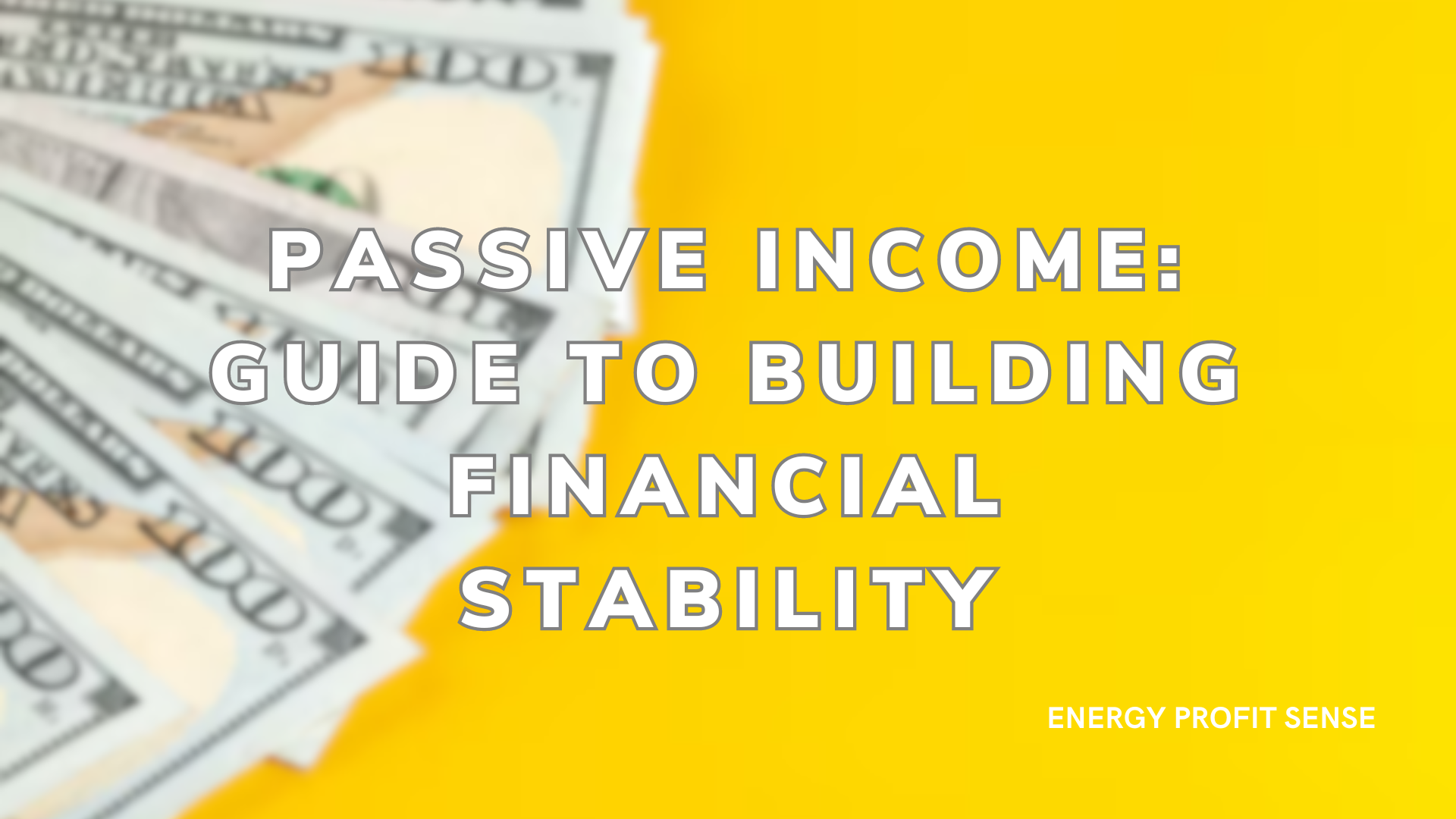Error: Contact form not found.
Passive income represents a vital strategy for achieving financial independence and security. Unlike active income, which requires continuous effort and time, passive income streams generate earnings with minimal ongoing involvement.
This guide delves into the various methods of creating passive income, the benefits of doing so, and practical steps to implement these strategies successfully.
What is Passive Income?
Passive income is earnings derived from ventures in which a person is not actively involved. This type of income requires an initial investment of time or money, but once established, it produces regular returns without requiring constant effort. Common examples include rental income, dividends from shares, earnings from a business that does not require daily management, and interest from savings accounts or bonds.
Benefits of Passive Income
- Financial Freedom: Passive income can supplement or even replace your primary income, giving you the financial freedom to pursue your passions, spend more time with family, or travel the world without worrying about a paycheck.
- Reduced Stress: With a steady stream of passive income, the financial pressure of maintaining a standard of living diminishes, reducing stress and enhancing your overall well-being.
- Wealth Building: Passive income streams can significantly contribute to wealth accumulation over time, especially when earnings are reinvested or saved.
- Work-Life Balance: Relying less on active income means you can work less, creating a better balance between work and personal life.
Starting Your Passive Income Journey
Identifying Your Goals
Before diving into passive income opportunities, it’s crucial to identify your financial goals. Do you aim to cover your monthly expenses, save for retirement, or achieve complete financial independence? Knowing your objectives helps in selecting suitable passive income opportunities.
Assessing Your Resources
Evaluate your available resources, including time, money, and skills. Some passive income streams require significant initial investments, while others demand specialized knowledge or skills. Understanding what you can contribute upfront will guide your choices.
Popular Passive Income Ideas
Real Estate Investments
Investing in real estate is a classic method for generating passive income. Here are some popular real estate strategies:
- Rental Properties: Purchasing properties to rent out can provide a steady monthly income. It involves the upfront cost of buying the property and potential ongoing costs for maintenance and management.
- Real Estate Investment Trusts (REITs): These are companies that own, operate, or finance income-producing real estate. Investing in REITs allows you to earn dividends from real estate without the hassle of managing properties.
- Crowdfunding Platforms: Real estate crowdfunding platforms enable you to invest in property projects with relatively low capital, earning a share of the rental income or profits from sales.
Dividend Stocks
Investing in dividend-paying stocks is another excellent passive income strategy. Companies that pay dividends distribute a portion of their profits to shareholders. By investing in these stocks, you can earn regular income without selling your shares.
- High Dividend Yield Stocks: Look for companies with a history of paying high dividends. These can provide a substantial passive income, particularly if the dividends are reinvested, compounding your returns over time.
- Dividend Growth Stocks: Companies that consistently increase their dividends offer growing income streams. This can help combat inflation and increase your passive income over the long term.
Bonds and Fixed Income Investments
Bonds and other fixed-income securities are secure ways to generate passive income. Here are some options:
- Government Bonds: These are typically low-risk investments that pay regular interest. They include treasury bonds, savings bonds, and municipal bonds.
- Corporate Bonds: These offer higher yields than government bonds but come with additional risk. It’s essential to assess the creditworthiness of the issuing company.
- Bond Funds: Investing in bond funds or exchange-traded funds (ETFs) allows diversification across multiple bonds, reducing risk and providing steady interest payments.
Peer-to-Peer Lending
Peer-to-peer (P2P) lending platforms connect borrowers with investors, allowing you to earn interest by lending money directly to individuals or businesses. This type of investment can yield high returns, but it’s crucial to understand the associated risks, as borrowers may default.
- Diversification: Spread your investments across multiple loans to mitigate risk.
- Platform Selection: Choose reputable P2P lending platforms with a track record of managing risk and providing good returns.
Creating and Selling Content
Content creation can be a lucrative source of passive income. Once you’ve created valuable content, you can earn money from it indefinitely. Here are some ideas:
- E-Books: Writing and publishing e-books on platforms like Amazon Kindle Direct Publishing can generate ongoing royalties from sales.
- Online Courses: If you have expertise in a particular area, creating online courses and selling them on platforms like Udemy or Teachable can provide consistent income.
- Stock Photos and Videos: If you’re skilled in photography or videography, selling your work on stock platforms like Shutterstock or Adobe Stock can earn you passive income from downloads.
Affiliate Marketing
Affiliate marketing involves promoting other companies’ products or services and earning a commission for each sale made through your referral. This can be done through blogging, social media, or other online platforms.
- Choose a Niche: Focus on a specific niche that you’re passionate about and has a good potential for affiliate products.
- Build an Audience: Create valuable content that attracts an audience. The more traffic you have, the higher your potential earnings from affiliate marketing.
Automating a Business
Launching a business that operates with minimal hands-on involvement can generate passive income. This often involves significant upfront work to set up, but it can eventually run itself with the help of automation and outsourcing.
- E-Commerce: Start an online store using platforms like Shopify or Amazon FBA. Once set up, you can automate inventory management, customer service, and marketing.
- Subscription Services: Create subscription-based products or services that provide ongoing value to customers. Examples include membership sites, subscription boxes, or software-as-a-service (SaaS) products.
Managing Passive Income Streams
Even though passive income requires less active involvement, it still demands regular monitoring and management to ensure its effectiveness.
Regular Review and Adjustment
Regularly review your income streams to assess performance. Are they meeting your financial goals? Do they require adjustments? Market conditions change, and sometimes an income stream may need tweaking to remain profitable.
Diversification
Avoid putting all your eggs in one basket. Diversify your passive income sources to spread risk. If one stream falters, others can pick up the slack, ensuring a steady flow of income.
Tax Considerations
Understanding the tax implications of your passive income is crucial for maintaining profitability. Different types of passive income are subject to various tax treatments.
- Consult a Tax Professional: A tax advisor can help you navigate the complexities of passive income taxation and devise strategies to minimize your tax liability.
- Keep Detailed Records: Maintain accurate records of your earnings and expenses related to passive income to ensure compliance and maximize deductions.
Challenges of Earning Passive Income
While the idea of passive income is appealing, it comes with its own set of challenges:
- Initial Effort and Investment: Setting up passive income streams requires a significant upfront investment of time, money, and effort. It may take months or even years before you start seeing returns.
- Risk and Volatility: Some passive income streams come with risks, such as market fluctuations, defaulting borrowers, or changing consumer trends.
- Ongoing Management: Even though it’s called “passive” income, it still requires regular monitoring and management to ensure profitability.
- Tax Implications: Different types of passive income are subject to various tax treatments, and it’s essential to understand these implications for accurate financial planning.
Conclusion
Passive income can be an attractive option for generating ongoing revenue without actively working. While there are challenges involved in setting up and managing passive income streams, the potential rewards can provide financial security and freedom.
With proper planning, diversification, and ongoing management, passive income can be a valuable addition to your overall financial portfolio.
So, it’s essential to research thoroughly, seek expert advice and continuously review your passive income strategies for long-term success. Happy investing!
Further Reading
- The Four-Hour Work Week by Tim Ferriss
- The Power of Passive Income by Nightingale-Conant –
- Rich Dad Poor Dad by Robert Kiyosaki –
- Passive Income Ideas: Top Streams to Boost Your Income by David J. Green
- Overall, passive income can provide financial stability and freedom, but it requires careful planning, ongoing management, and an understanding of the potential challenges. With the right mindset and strategies, you can create a passive income portfolio that supports your financial goals and provides greater flexibility in your life. Best of luck on your passive income journey! Happy investing! Before we conclude this guide, it’s important to note that there are endless possibilities for generating passive income. This guide has only scratched the surface and provided some popular ideas to get you started.
Passive income is a type of unearned income that is acquired with little to no labor to earn or maintain. It is often combined with another source of income, such as regular employment or a side job.[1] Passive income, as an acquired income, is taxable.
Examples of passive income include rental income and business activities in which the earner does not materially participate. Some jurisdictions’ taxing authorities, such as the Internal Revenue Service in the United States, distinguish passive income from other forms of income, such as income from regular or contractual employment, and may tax it differently.





